

Sweeping bipartisan retirement legislation took the industry by storm last month, with committees in both the House and Senate floating bills that not only make it easier to offer annuities in 401(k) and 403(b) plans, but they also raise the age for taking required minimum distributions from 70 ½ to 72, and expand 529 plan use to homeschooling.
The House Ways and Means Committee approved the Setting Every Community Up for Retirement Enhancement Act of 2019, or SECURE Act, H.R. 1994, while the Senate Finance Committee introduced the Retirement Enhancement and Savings Act (RESA) of 2019, which is similar to the SECURE Act.
Lots of chatter has ensued among retirement planning experts since the bills' introduction, with talking pointing on the drawbacks and benefits.
In mid-April, Brian Graff, CEO of the American Retirement Association, told me that "all signals continue to be positive and we continue to be bullish on prospects for House and Senate action this year" on the bills. House action on the SECURE Act, he said, could come as soon as May.
The Senate bill "is virtually identical" to a House bill introduced earlier this year, which was amended Friday with additional provisions and renamed the SECURE Act, according to the Insured Retirement Institute.
During the Act's markup, House Ways & Means Committee Chairman Richard Neal, D-Mass., stated that one of his "top priorities" as chairman "is to help workers of all ages prepare for a financially secure retirement."
Americans, Neal said, "currently face a retirement income crisis, with too many people in danger of not having enough savings to maintain their standard of living and avoid sliding into poverty. The SECURE Act goes a long way in addressing this problem by making it easier for Americans to save. Passage of this bill is a tremendous bipartisan accomplishment, and I hope to see the measure move through Congress and be signed into law in short order."
Senate Finance Committee Chairman Chuck Grassley, R-Iowa, and ranking member Ron Wyden, D-Ore., said their RESA bill is the result of "the best ideas" from retirement discussions held by lawmakers since 2006.
Originally introduced in November 2016, RESA was again introduced April 1 with technical modifications.
Former Obama Official Weighs In
Elizabeth Kelly, the former special assistant to the president on the National Economic Council for the Obama administration, sees the "most significant" changes included in the SECURE Act and RESA bill falling into two buckets: efforts to get more small businesses to offer workplace retirement savings plans and changes to IRA rules, including on required minimum distributions.
Kelly, now senior vice president of operations at United Income, a retirement planning firm, told me in an email message that both the RESA bill and the SECURE Act "would allow older Americans still in the workforce to continue making tax-deferred contributions to traditional IRAs after age 70.5, rather than just post-tax contributions to Roth IRAs and brokerages."
While intended to help older Americans who are still working, Kelly said, "this is a small percentage of the population: 14.09% of people age 71-80 report being in the labor force," citing the January 2019 Current Population Survey.
Both bills, Kelly points out, "would also raise revenue by requiring inheritors of 401(k) plan and IRA balances (with some exceptions, like spouses or minor children) to withdraw the entirety of the balance within 10 years of the account owner's death."
The "primary mechanism" in the RESA bill is to allow small businesses "to band together and create so-called open multiple employer plans, rather than offering a plan alone or requiring a 'common bond' between employers as under current law," Kelly explained.
Indeed, Grassley said on the Senate floor in early April that the RESA bill "is paid for," with the main offsetting provision involving the "option under current law for a person to pass along his or her IRA or 401(k) account to a family member or other beneficiary."
Under current law, Grassley said, "the recipient of that account can keep the inherited funds in the tax deferred account and save for their own retirement if they take out a required minimum distribution amount each year," what's often referred to as a stretch IRA.



